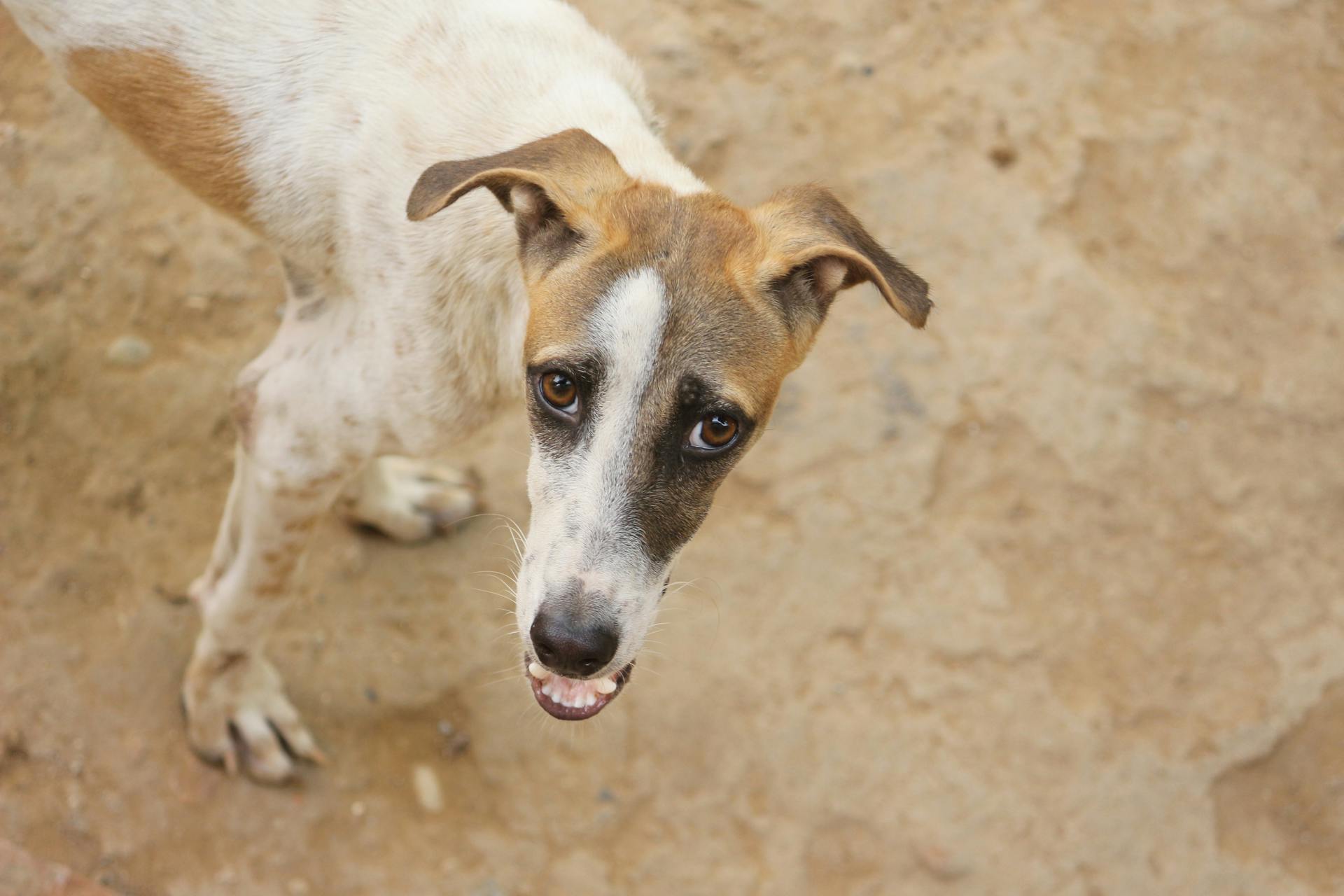
Sighthounds have been around for thousands of years, with evidence of their existence dating back to ancient civilizations in Egypt and Greece. They were bred to hunt small game like gazelles and rabbits.
Their speed and agility made them well-suited for this task. With some breeds reaching speeds of up to 40 miles per hour.
One of the key characteristics of sighthounds is their slender build, which allows them to cover long distances with ease. This build also makes them less suited for tasks that require strength or endurance.
Their short coats and minimal body fat help them conserve energy while running. It's not uncommon to see sighthounds with a lean, athletic appearance.
What Are Sighthounds?
Sighthounds are a group of hunting dogs that use their sharp vision to detect their prey rather than relying on scent.
These dogs are built for speed, with a body constructed to maximize their running efficiency and agility. They have a springy spine and flexible body that propels them forward, enabling their unique double suspension gait.
Sighthounds can reach speeds of up to 45 miles per hour, making them some of the fastest dogs around.
History
Sighthounds have a rich history that spans thousands of years. The earliest presumed sighthound remains date back approximately 4,000 years before present, found in the excavations of Tell Brak with a male sighthound around 54 cm in shoulder height.
The Celtic vertragus, a type of sighthound, was described in Roman Spain of the 2nd century C.E. by Arrian in his Cynegeticus. This is the earliest complete European description of a sighthound and its work.
A similar type of sighthound, the Warmington Roman dog, was found in England with a height of 61–63 cm. This well-preserved skeleton dates back to the same historic period as the Celtic vertragus.
Genetic analysis has shown that sighthound type "gracile" bones, dating from the 8th to 9th century CE, are almost identical to the modern Greyhound breed. This is based on a comparison of DNA sequences, with only four deletions and one substitution found in the modern Greyhound.
Population genomic analysis proposes that true sighthounds originated independently from native dogs and were comprehensively admixed among breeds. This supports the multiple origins hypothesis of sighthounds.
Explore further: Spanish Greyhound vs Greyhound
Appearance
Sighthounds have a distinctive appearance that's shaped by their evolution for speed and agility. Their heads are typically light and lean, with a dolichocephalic shape that creates the illusion of being longer than usual.
This dolichocephalic shape gives them a wider field of vision, but their eyes are farther apart, which might make it harder to judge depth in some parts of their field of view. Most dogs, including sighthounds, have less visual acuity than wolves, their wild ancestors.
Sighthounds have extremely aerodynamic bodies, with slender bones and a noticeable "tuck-up" or waist. This body shape is a result of their need for speed, and it's not just for show - it's essential for their survival in the wild.
Characteristics
In terms of characteristics, most people can be classified into three main categories: ectomorphs, mesomorphs, and endomorphs. Ectomorphs have a slender build and tend to have a harder time gaining weight.
Their bodies are naturally more efficient at burning calories, which can make it difficult for them to put on muscle mass. This category is often associated with athletes who are naturally lean and agile.
Mesomorphs, on the other hand, tend to have a more athletic build and can easily gain muscle mass. They often have a strong metabolism and can maintain a healthy weight with minimal effort.
Endomorphs, however, tend to have a rounder build and may struggle with weight loss due to their slower metabolism. They often have to work harder to maintain a healthy weight.
If this caught your attention, see: Healthy Bulldog Breeds
Size
Sighthounds have evolved extremely aerodynamic bodies, with relatively slender bone and a noticeable "tuck-up", or waist.
Their bodies are designed for speed, not for storing fat, and as a result, they are born with low stores of body fat.
In fact, an overweight Sighthound would never survive in extreme temperatures over challenging terrain, as their primitive, utilitarian hunter ancestors did.
A Sloughi in prime condition should have a defined bony structure, with the rearmost three ribs faintly visible, prominent hipbones, bony croup, and up to three vertebrae showing.
Sighthounds that pack on the pounds can put undue stress on their joints and soft tissue, making them more prone to injuries.
It's helpful to think of Sighthounds as runners, not as dogs that should have the same body type as other breeds.
Coat

Your coat is a crucial part of your overall appearance, and it can make or break your style.
A well-fitted coat can instantly elevate your look, while a poorly fitted one can make you look sloppy. For example, a coat that's too long can overwhelm your frame, while one that's too short can leave you looking like you're wearing a poncho.
In terms of color, neutral tones like black, navy, and gray are versatile and can be paired with just about anything. These colors are also great for creating a timeless look that won't go out of style anytime soon.
List of Sighthounds
The Greyhound is one of history's most celebrated canines, dating back over 5,000 years to ancient Egypt. As the fastest of all dog breeds, it's no wonder they're a favorite among many dog owners.
The Greyhound is one of many sighthound breeds, which are known for their speed and agility. Let's take a look at the many breeds that make up this group.
Some of the most well-known sighthound breeds include the Afghan Hound, Borzoi, and Whippet. The list of sighthound breeds is quite extensive, with over 20 different breeds to choose from.
Here's a list of some of the sighthound breeds mentioned in the article:
- Afghan Hound
- Azawakh
- Borzoi
- Chippiparai
- Chortai
- Galgo Español
- Greyhound
- Irish Wolfhound
- Italian Greyhound
- Kaikadi
- Kanni
- Kazakh Tazy
- Kombai
- Levriero Sardo
- Magyar agár
- Mudhol Hound
- Old Croatian Sighthound†
- Patagonian Greyhound
- Polish Greyhound
- Rajapalayam
- Rampur Greyhound
- Rhodesian Ridgeback
- Saluki
- Scottish Deerhound
- Silken Windhound
- Sloughi
- Taigan
- Whippet
- Xigou
Greyhound
The Greyhound is a very ancient breed, dating back over 5,000 years to ancient Egypt.
They are built for speed, with a slender build and smooth coat, and can reach speeds of up to 40 mph.
Greyhounds come in two varieties: NGA (racing) and AKC (show), and are known for their gentle, loyal, and loving nature.
However, they can have a strong prey drive and may not be suitable for households with small animals.
Regular exercise is a must for Greyhounds, as they can become "couch potatoes" if not provided with enough physical activity.
Despite their sensitive personality, Greyhounds are very affectionate with families and can make great companions.
They require minimal grooming due to their short coat, but regular nail trims and dentals are essential to keep them healthy.
Greyhounds have a long history, dating back to ancient Egypt, where they were a favorite among royals.
They were initially bred for hunting and later transitioned to competitive coursing and track racing, but today, they are mostly kept as household companions.
The Greyhound's popularity has endured despite the decline of track racing, and they remain a beloved breed among many dog enthusiasts.
A unique perspective: Racing Dogs Breeds
Whippet
The Whippet is a breed of sighthound that originated in the 1800s in England. They are known for their sleek, curvy build and short, smooth coat.
Whippets are sprinters by nature and require regular exercise to keep them happy and healthy. They love to stretch and relax for hours in between bursts of intense pursuit.
They are great apartment dogs as long as they get several vigorous play sessions per week. This means you'll need to make time for playtime with your Whippet, whether it's a run around the block or a game of fetch in the park.
Whippets are relatively low maintenance when it comes to grooming, requiring only regular nail trims to keep them looking their best. Their short coat means they don't shed much, making them a great choice for people with allergies.
Here are some key facts about Whippets:
Whippets are calm and low-key in the home, but they do require regular exercise to keep them happy and healthy. With their short, smooth coat and low maintenance grooming needs, they make a great choice for anyone looking for a sighthound that's easy to care for.
Italian Greyhound
The Italian Greyhound is a delightful breed that makes a great companion or family pet. They are playful, alert, and sensitive dogs that thrive on attention and interaction.
Their short, smooth coat requires minimal grooming, but they do need daily teeth brushing and yearly dentals to maintain good dental health.
One thing to keep in mind when exercising your Italian Greyhound is that they can be prone to chasing small animals, so it's essential to keep them on a leash when not in a fenced area.
Italian Greyhounds are relatively small in size, with males weighing between 60-65 pounds and females weighing between 50-55 pounds.
They have a relatively long lifespan, living for 14-15 years on average.
For more insights, see: Small Dog Types with Pictures
Afghan Hound
The Afghan Hound is a majestic breed with a rich history.
This ancient breed originated in Afghanistan around 8,000 B.C.–0 A.D. and is known for its stunning appearance.
One of the Afghan Hound's most distinctive features is its flowing silky hair, which serves as a protective cover against the harsh climate of its native country.
The breed's lifespan is relatively long, ranging from 12–18 years.
The Afghan Hound typically stands between 25–27 inches tall.
Here are some key statistics about the Afghan Hound:
Frequently Asked Questions
What is the rarest breed of sighthound?
The Azawakh is a rare and unusual sighthound breed known for its exceptional hunting skills and loyal nature. This African breed excels at tracking prey visually, making it a unique addition to the sighthound family.
What is the best sighthound?
The Afghan Hound is often considered the best sighthound due to its impressive speed and distinctive appearance. However, other breeds like the Saluki and Greyhound are also highly regarded for their hunting abilities and sleek features.
Are sighthounds good pets?
Yes, sighthounds can make great family pets due to their loving nature. They have large hearts, literally, which means they have plenty of love to give.
What is the king of sight hounds?
The Afghan Hound is known as the King of Sight Hounds due to its majestic heritage and ancient lineage. This title reflects its status as one of the oldest and most revered breeds in the world.
What is the difference between a sighthound and a greyhound?
Sighthounds are a broader category of dogs that include Greyhounds, characterized by their speed and keen eyesight, while Greyhounds are a specific breed within this group, known for their athletic ability and short coats
Featured Images: pexels.com


